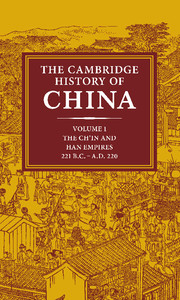Book contents
- Frontmatter
- Introduction
- 1 The state and empire of Ch'in
- 2 The Former Han dynasty
- 3 Wang Mang, the restoration of the Han dynasty, and Later Han
- 4 The conduct of government and the issues at stake A.D. 57–167
- 5 The fall of Han
- 6 Han foreign relations
- 7 The structure and practice of government
- 8 The institutions of Later Han
- 9 Ch'in and Han law
- 10 The economic and social history of Former Han
- 11 The economic and social history of Later Han
- 12 The religious and intellectual background
- 13 The concept of sovereignty
- 14 The development of the Confucian schools
- 15 Confucian, Legalist, and Taoist thought in Later Han
- 16 Philosophy and religion from Han to Sui
- Bibliography
- Glossary-Index
- Map 7 The Han empire, 143 b.c.
- Map 8 The Han empire, 108 b.c
- Map 9 The Han empire, a.d. 2
- Map 12 The Han empire, a.d. 140">
- References
13 - The concept of sovereignty
Published online by Cambridge University Press: 28 March 2008
- Frontmatter
- Introduction
- 1 The state and empire of Ch'in
- 2 The Former Han dynasty
- 3 Wang Mang, the restoration of the Han dynasty, and Later Han
- 4 The conduct of government and the issues at stake A.D. 57–167
- 5 The fall of Han
- 6 Han foreign relations
- 7 The structure and practice of government
- 8 The institutions of Later Han
- 9 Ch'in and Han law
- 10 The economic and social history of Former Han
- 11 The economic and social history of Later Han
- 12 The religious and intellectual background
- 13 The concept of sovereignty
- 14 The development of the Confucian schools
- 15 Confucian, Legalist, and Taoist thought in Later Han
- 16 Philosophy and religion from Han to Sui
- Bibliography
- Glossary-Index
- Map 7 The Han empire, 143 b.c.
- Map 8 The Han empire, 108 b.c
- Map 9 The Han empire, a.d. 2
- Map 12 The Han empire, a.d. 140">
- References
Summary
There are a number of references in previous chapters to events and decisions that bore significantly on the development of China's political ideal: a single empire governed centrally by a duly acknowledged emperor whose legitimacy could not be challenged by a rival regime. To achieve this ideal and to maintain it in practice, the governments of China have nearly always found it necessary to call on the support of religious and intellectual sanction, as may be seen to some extent even in the case of the practical statesmen of Ch'in, at the outset of the imperial period.
Such a need stands revealed, for example, in the deliberate search for a suitable title, and the adoption of huang-ti (emperor); and in the successive adoption of water, earth, and fire as the patron elements of a dynasty. The principle is likewise illustrated in the invocation of extraordinary events of nature as omens which displayed the blessings that a contemporary regime enjoyed-or, alternatively, as a means of conveying Heaven's warning to rulers to mend their ways. It has also been shown how attempts were made to explain dynastic change or continuity as matters of necessity, required by the demands of a superior cosmic rhythm. In this chapter an attempt will be made to elaborate some of the ideas that were involved and place them in their intellectual context.
CHANGING ATTITUDES: 221 B.C. TO A.D. 220
One of the principal legacies that the Han dynasty bequeathed to its successors was the demonstration that imperial sovereignty was a respectable means of government which statesmen could serve with loyalty and with due deference to the ethical ideals on which they had been nurtured.
- Type
- Chapter
- Information
- The Cambridge History of China , pp. 726 - 746Publisher: Cambridge University PressPrint publication year: 1986
References
- 5
- Cited by

